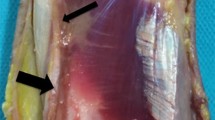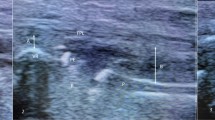Abstract
Background
The purpose of this study was to determine the anatomical features of the pronator quadratus muscle related to minimally invasive plate osteosynthesis for distal radius fractures.
Methods
Ten cadaver forearms were used. The width from the proximal edge to the distal edge of the muscle and the distance from the distal edge of the muscle to the joint surface of the distal radius were measured. After inserting the plate under the pronator quadratus muscle, the distal part of the plate was held over the distal part of the radius and the proximal part of the plate was lifted up from the radius with a fixed locking sleeve. When the pronator quadratus muscle fiber showed signs of tearing, the distance from the volar cortex of the radius to the proximal edge of the plate was measured.
Results
The average width of the pronator quadratus muscle was 35.4 mm. The average distance from the pronator quadratus muscle to the joint surface of the distal radius was 16.6 mm, and the average distance from the cortex to the proximal edge of the plate was 12.2 mm.
Conclusions
The length of the plate should be more than 52 mm to prevent damage to the pronator quadratus muscle. Adjustment of the position of the plate under the muscle should be done in a 12-mm area under the pronator quadratus muscle. The data might provide a useful basis regarding the potential efficacy of minimally invasive plate osteosynthesis for the preservation of pronator quadratus muscle.





Similar content being viewed by others
References
Krettek C, Müller M, Miclau T (2001) Evolution of minimally invasive plate osteosynthesis (MIPO) in the femur. Injury 32:14–23
Apivatthakakul T, Chiewcharntanakit S (2009) Minimally invasive plate osteosynthesis (MIPO) in the treatment of the femoral shaft fracture where intramedullary nailing is not indicated. Int Orthop 33:1119–1126
Hazarika S, Chakravarthy J, Cooper J (2006) Minimally invasive locking plate osteosynthesis for fractures of the distal tibia—results in 20 patients. Injury 37:877–887
Collinge C, Kuper M, Larson K, Protzman R (2007) Minimally invasive plating of high-energy metaphyseal distal tibia fractures. J Orthop Traoma 21:355–361
Gardner MJ, Griffith MH, Dines JS, Lorich DG (2004) A minimally invasive approach for plate fixation of the proximal humerus. Bull Hosp Jt Dis 62:18–23
Gardner MJ, Voos JE, Wanich T, Helfet DL, Lorich DG (2006) Vascular implications of minimally invasive plating of proximal humerus fractures. J Orthop Trauma 20:602–607
Laflamme GY, Rouleau DM, Berry GK, Beaumont PH, Reindl R, Harvey EJ (2008) Percutaneous humeral plating of fractures of the proximal humerus: results of a prospective multicenter clinical trial. J Orthop Traoma 22:153–158
Lau TW, Leung F, Chan CF, Chow SP (2007) Minimally invasive plate osteosynthesis in the treatment of proximal humeral fracture. Int Orthop 31:657–664
Zhiquan A, Bingfang Z, Yeming W, Chi Z, Peiyan H (2007) Minimally invasive plating osteosynthesis (MIPO) of middle and distal third humeral shaft fractures. J Orthop Trauma 21:628–633
An Z, Zeng B, He X, Chen Q, Hu S (2010) Plating osteosynthesis of mid-distal humeral shaft fractures: minimally invasive versus conventional open reduction technique. Int Orthop 34:131–135
Jiang R, Luo CF, Zeng BF, Mei GH (2007) Minimally invasive plating for complex humeral shaft fractures. Arch Orthop Trauma Surg 127:531–535
Kobayashi M, Watanabe Y, Matsushita T (2010) Early full range of shoulder and elbow motion is possible after minimally invasive plate osteosynthesis for humeral shaft fractures. J Orthop Trauma 24:212–216
Imatani J, Noda T, Morito Y, Sato T, Hashizume H, Inoue H (2005) Minimally invasive plate osteosynthesis for comminuted fractures of the metaphysis of the radius. J Hand Surg Br 30:220–225
Kiyoshige Y (2002) Condylar stabilizing technique with AO/ASIF distal radius plate for Colles’ fracture associated with osteoporosis. Tech Hand Up Extrem Surg 6:205–208
Kiyoshige Y (2005) Condylar stabilizing technique for intra-articular fracture of the distal radius. Tech Hand Up Extrem Surg 9:17–20
Tobe M, Mizutani K, Tsubuku Y, Yanagihara Y (2006) Minimally invasive plate osteosynthesis for distal radius fractures: surgical technique. Riv Chir Mano 3:280–284
Sen MK, Harvey EJ (2008) Minimally invasive plate osteosynthesis of distal radius fractures using a pronator sparing approach. Tech Hand Up Extrem Surg 12:2–6
Stuart PR (1996) Pronator quadratus revisited. J Hand Surg Br 21:714–722
McConkey MO, Schwab TD, Travlos A, Oxland TR, Goetz T (2009) Quantification of pronator quadratus contribution to isometric pronation torque of the forearm. J Hand Surg Am 34:1612–1617
Rath S, Hung LK, Leung PC (1990) Vascular anatomy of the pronator quadratus muscle-bone flap: a justification for its use with a distally based blood supply. J Hand Surg Am 15:630–636
Lee JC, Lim J, Chacha PB (1997) The anatomical basis of the vascularized pronator quadratus pedicled bone graft. J Hand Surg Br 22:644–646
Lamas C, Llusa M, Mendez A, Proubasta I, Carrera A, Forcada P (2009) Intraosseous vascularity of the distal radius: anatomy and clinical implications in distal radius fractures. Hand (NY) 4:418–423
Johnson RK, Shrewsbury MM (1976) The pronator quadratus in motions and in stabilization of the radius and ulnar at the distal radioulnar joint. J Hand Surg Am 1:205–209
Acknowledgment
The authors gratefully acknowledge the editorial assistance of Kay Daugherty.
Conflict of interest
The authors declare that they have no conflict of interest.
Author information
Authors and Affiliations
Corresponding author
Rights and permissions
About this article
Cite this article
Takada, N., Otsuka, T. Anatomical features of the pronator quadratus muscle related to minimally invasive plate osteosynthesis of distal radial fractures with a volar locking plate: a cadaver study. Eur Orthop Traumatol 2, 133–136 (2011). https://doi.org/10.1007/s12570-011-0079-1
Received:
Accepted:
Published:
Issue Date:
DOI: https://doi.org/10.1007/s12570-011-0079-1




